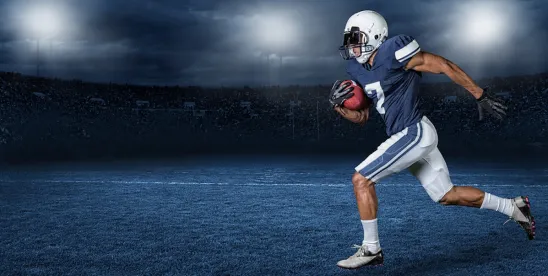In February, McNeese State’s basketball manager, Amir “Aura” Khan, rose to fame when a video featuring him went viral on X/Twitter. In the video, Khan led players out of the locker room with a boombox on his shoulder while rapping along to “In and Out” by Lud Foe. The video garnered millions of views and earned Khan name, image, and likeness (NIL) deals with TickPick, Insomnia Cookies, and others in excess of $100,000. Khan’s moment is emblematic of the new age for college sports, where brands seek to engage with prized demographics and student-athletes have new opportunities to benefit from the use of their NIL.
The NCAA’s 2021 decision to permit student-athletes to earn compensation from the use of their NIL fundamentally altered the landscape of college athletics. Student-athletes (and even aspiring student managers) are now permitted to profit from their personal brand, creating new opportunities, and considerations, within the realm of sports representation at the collegiate level. As college athletes sign endorsement deals at increasingly younger ages, the legal and regulatory issues surrounding NIL and the representation of student-athletes are becoming more complex.
NIL Evolution
In June 2021, the Supreme Court issued its decision in Alston v. NCAA.[1] In a unanimous ruling, the Court upheld a lower court’s finding that the NCAA’s restrictions on education-related benefits for athletes were anticompetitive. While the Alston decision did not directly address NIL, it reinforced antitrust scrutiny of NCAA compensation limits and catalyzed the NCAA’s decision to revise its NIL rules in July 2021.
The Alston case, while related, is distinct from House v. NCAA, a class action lawsuit challenging the NCAA’s long-standing restrictions on athlete compensation. In June 2025, a final approval of the settlement was granted, permitting schools to share up to $20.5 million in revenue directly with student-athletes.[2] The settlement also introduces several compliance measures. For example, in order to assess the fair market value and legitimacy of third-party NIL agreements, Division I athletes will be required to report deals exceeding $600 to an independent clearinghouse. The settlement reflects a seismic shift toward a more centralized, regulated, and revenue-sharing model in college athletics. Some analysts warn that this new oversight mechanism – especially regarding what qualifies as a valid NIL deal – could reduce the value of certain NIL arrangements, particularly those that resemble “pay to play” incentives rather than conventional brand endorsement deals.
On July 1, 2021, the NCAA implemented a policy allowing student-athletes to monetarily benefit from their NIL, even in states that have not enacted NIL legislation, and to use professional services providers, such as agents, for NIL activities.[3] For decades prior, NCAA athletes were prohibited from receiving any form of financial compensation beyond potential athletic scholarships. Now, agencies play a critical role in managing athletes’ personal brands – often before they step foot on a college campus.
The increasing scale of the NIL marketplace is evident in the projected earnings of top athletes over a 12-month period. On3, a media outlet focused on college sports, recently estimated that Arch Manning (projected top NFL draft pick) has an NIL valuation of $6.8 million, with Carson Beck (projected number 7 NFL draft pick) at $4.3 million and The Ohio State University wide receiver Jeremiah Smith at $4.2 million.[4]
A New Class of Agents
Historically, athlete representation has primarily focused on professional athletes, with agents becoming involved only after an athlete turned pro. However, with college athletes now legally permitted to monetize their personal brand and NIL earlier in their careers, a growing number of new agencies are entering the NIL space, seeking to represent college and even high school athletes. Further, many traditional agencies are exploring NIL opportunities.
This shift has created new challenges for athletes, schools, and advisors navigating the evolving regulatory landscape. It has also introduced a distinct category of representation—NIL agents—whose roles and obligations differ in key ways from those of traditional sports agents:
- Scope of Representation: Traditional agents primarily negotiate playing contracts with professional teams. NIL agents, by contrast, focus on endorsement deals, branding, social media strategy, and content monetization.
- Compensation Structure: Both types of agents typically earn a commission, but traditional agents usually receive 3–5% of team contract values, while NIL agents may charge 10–20% of earnings from brand partnerships and content deals.
- Regulatory Oversight: Traditional agents must be licensed by the professional leagues in which their clients play and must comply with applicable CBAs. NIL agents operate under an evolving mix of state laws, institutional policies, and NCAA guidelines, with no unified national licensing system currently in place.
- Timing of Engagement: Traditional agents generally work with athletes entering or already in the professional ranks. NIL agents engage with athletes in the beginning of, or sometimes before, their collegiate playing careers begin.
The Issues of Timing and Informed Consent
The representation of pre-collegiate and collegiate athletes implicates important legal considerations regarding informed consent and contract enforceability. In California, for example, a contract with a minor is voidable by the minor until they reach adulthood, but the obligations of any adult party to that contract remain enforceable. While California courts have the power to affirm certain types of contracts (in which case, the contract cannot be voided on the grounds that a party was a minor when the contract was signed), NIL representation agreements do not necessarily fit into the categories of contracts that such courts have the power to affirm. NIL agents operating in California and states with similar laws should be mindful that, absent court approval or specific statutory protection, contracts with minor athletes may be voided—potentially after significant performance has already occurred—leaving the adult party bound while the minor walks away.
In addition, with many athletes still in their teenage years when they sign NIL deals, questions may arise about whether they fully understand the terms and long-term implications of their agreements. One relevant case involves Chicago Bears defensive lineman Gervon Dexter, who filed a federal lawsuit seeking to void his agreement with a NIL group on the basis that it was predatory.[5] According to reports, under the agreement, signed in 2022 while Dexter was a student, Dexter agreed to pay the agency 15% of his pre-tax NFL earnings for 25 years in exchange for a one-time payment of $436,485. For context, the current average NFL salary is approximately $3.2 million per season. Though the case is still pending, Florida lawmakers have expressed support for Dexter’s position and argue that his NIL deal does not comply with Florida’s NIL laws.
To date, over 30 states have enacted NIL laws, while others have introduced NIL-related legislation. No two states’ laws are the same – they vary regarding the protections in place for athletes, when athletes can and cannot promote their NIL, agency licensing requirements, disclosure obligations, who can compensate athletes, how compensation can be structured, and other aspects. A federal framework could potentially provide more consistency across jurisdictions. The U.S. House of Representatives has recently introduced the Student Compensation and Opportunity through Rights and Endorsements (“SCORE”) Act, a bipartisan bill that seeks to standardize NIL protections nationwide, regulate agents representing student athletes, and prevent universities from revoking scholarships due to injury or poor performance. In addition, press reports indicate that the President is considering issuing an executive order directing the National Labor Relations Board to clarify whether college athletes qualify as school employees. While proponents of a national legislative framework believe these efforts will provide a more sustainable future for college sports, others express concern that federal interaction would centralize control in the NCAA and limit athlete’s rights.
Other Legal Challenges for NIL Deals and the NCAA’s Role
As NIL deals proliferate, legal disputes may become more frequent – particularly where the terms of the deal are unclear or athletes are not well-versed in contract law. Agents face heightened exposure in this environment, especially when representing multiple athletes in the same sport or position, or when they maintain business relationships with brands seeking deals with their clients. These scenarios raise serious conflict of interest concerns that may implicate both legal ethics and state NIL compliance requirements.
Perhaps the most significant legal challenge, however, remains the NCAA’s evolving and inconsistent approach to the regulation of NIL. While the NCAA now permits athletes to profit from their NIL, it has yet to adopt a uniform and comprehensive set of policies. This regulatory vacuum has created a fragmented system as schools and states implement varying rules to fill the gap, complicating matters for both athletes and their agencies.
The Future of NIL
As the NIL market continues to grow, legal and regulatory frameworks will likely continue to evolve. Industry observers anticipate ongoing discussions regarding standardization of NIL deals and potential movement toward more uniform regulations across states and schools. At the same time, the role of agencies continues to grow as more student-athletes seek professional representation. Legal practitioners can contribute to this developing area by providing guidance on clear contractual agreements, compliance considerations and relevant legal protections.
5 Key Takeaways for Student-Athletes
- Understand your rights and obligations under any NIL contract.
- Work with trusted and experienced advisors who have your best interests in mind.
- Consider the long-term implications of any NIL deal in addition to the short-term effects.
- Do not feel pressured to sign the first deal presented to you.
- Stay educated on the evolving legal landscape.
5 Key Takeaways for Agencies
- Understand the current state and federal legal landscape.
- Prepare for further regulation and changes to the legal landscape.
- Ensure clear and transparent NIL contracts.
- Consider conflicts of interest caused by other clients and business relationships.
- Develop partnerships that align with athletes’ personal values to maximize long term success.
FOOTNOTES
[1] National Collegiate Athletic Association v. Alston et al., No. 20-512, slip op. (U.S. March 31, 2021).
[3] NCAA adopts interim name, image and likeness policy | NCAA.com
[5] Florida legislator says Bears DT Gervon Dexter’s NIL deal violated law – ESPN
Caroline Heffernan also contributed to this article.



 />i
/>i

